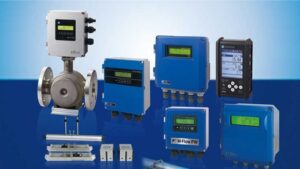What Is A Coriolis Flow Meter And How Does It Work?

Coriolis flow meters have gained popularity over the years across a variety of manufacturers and heavy-duty industries, including water and wastewater, oil and gas, and more, for liquid and gas monitoring and measurement. The starting costs can be higher than other types of metering, but the precision, speed, and mass measurement rather than just volume and low maintenance costs have increased the demand for Coriolis flow meters.
What is a Coriolis Flow Meter?
Coriolis mass flow meter feature instrumentation that works based on the Coriolis effect or the inertia produced by fluid or gas flowing through oscillating tubes. Due to this inertia, the tube twists according to the mass flow rate. Sensors track this twisting to produce a linear flow signal.
The Coriolis mass flow meters are available in various diameters, shapes, and materials, depending on the flow rate, fluid, and specific design depending on the manufacturer. All of these Coriolis meters have three things in common: the meter is a tube, a force is applied to the tube, and a measuring device is used to track tube movement.
How Does Coriolis Flow Meter Work?
With the inertia method, Coriolis mass flow meters measure mass. Coriolis mass flow meters work by vibrating a tube with a tiny actuator, a liquid or gas flowing through it. This creates a twisting force in the tube, which is related to the amount of mass flowing through it. The meter measures this twisting force (high frequency) to figure out how much mass is moving through the tube. Coriolis mass flow meters can measure the mass flowing forward or backward in the tube.
A magnetic coil is used to create an opposing vibration between the tubes in some two-tubed Coriolis flow meter designs. The flow tubes’ inlet and outlet magnetic and coil components serve as sensors. The magnet then generates a magnetic field, and when the coils move across this field, they produce a sine wave. The sine waves at the inlet and outflow of the Coriolis meter are in phase with one another when no current is flowing through it. In direct proportion to the mass flow through the tubes, the tubes begin to twist. The timing difference in the sine waves between the two sensors is successfully detected by the sensors as the phase shifts, figuring out how much mass is moving through the tube.
Applications & Limitations of Coriolis Mass Flow Meters
Coriolis Mass Flow Meters are widely used in challenging, critical industrial applications such as power, oil and gas, chemical, water and wastewater, pharmaceutical, food and beverage, and other manufacturing industries.
Coriolis flow meter common applications include:
- Low to high-flow rate applications
- Fiscal custody transfer
- Critical applications for liquid, gas, and slurry
Few of the limitations include:
Coriolis flow meters can be expensive, have limited turndown ratios, and may not handle high-viscosity fluids well. The installation and maintenance of Coriolis flow meters can be difficult, and they are sensitive to environmental conditions.
Purchase Flow Metering Instruments
Litrols provides a wide range of Coriolis Meter and Coriolis Flow Meter Transmitter from various recognized brands. With our comprehensive Process Instrumentation services and solutions, we can design, install, and maintain flow metering systems as per your industrial requirements.

